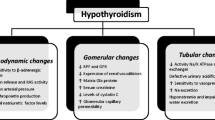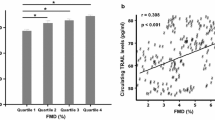Abstract
Thyroid diseases may lead to endothelial dysfunction; however, the mechanism underlying the endothelial dysfunction in thyroid disease is not clear yet. Asymmetric dimethylarginine (ADMA), a novel inhibitor of endothelial nitric oxide synthase (eNOS), blocks nitric oxide (NO) synthesis from Larginine. Symmetric dimethylarginine (SDMA) is the structural isomer of the eNOS inhibitor ADMA. SDMA does not directly inhibit eNOS but is a competitive inhibitor of arginine transport. Increased plasma ADMA, SDMA concentrations, and low Larginine/ADMA ratio were considered as possible contributing factors for endothelial dysfunction in hyperthyroid patients. On the other hand, plasma ADMA, SDMA levels and L-arginine/ADMA ratio in the hypothyroid group were unexpectedly found to be similar to those of the control subjects. The aim of this study is to evaluate and compare the plasma ADMA levels in hyperthyroid, hypothyroid and healthy subjects. Plasma ADMA, SDMA, and L-arginine levels were measured by high performance liquid chromatography. Plasma ADMA levels were significantly higher in both patients with hyperthyroidism and hypothyroidism than in the control group. SDMA concentrations were significantly increased in hypothyroid patients compared to control subjects. Patients with hyperthyroidism and hypothyroidism had significantly higher plasma L-arginine levels compared with healthy controls. L-arginine/ADMA ratio, which shows NO bioavailability, was significantly lower in hyperthyroid patients than in both hypothyroid and control subjects. In hyperthyroidism, plasma ADMA levels were related to age, L-arginine, and SDMA levels. SDMA was associated with age and L-arginine. L-arginine/ADMA ratio was negatively associated with freeT4 levels. There was a relationship between ADMA and L-arginine in hypothyroid patients. SDMA was significantly related to L-arginine, total cholesterol, and LDL. In conclusion, not only hyperthyroidism but also hypothyroidism was associated with alterations of ADMA and SDMA metabolism.
Similar content being viewed by others
References
Vargas F, Moreno JM, Rodriguez-Gomez I, et al. Vascular and renal function in experimental thyroid disorders. Eur J Endocrinol 2006, 154: 197–212.
Furchgott RF, Vanhoutte PM. Endothelium-derived relaxing and contracting factors. FASEB J 1989, 3: 2007–18.
Forstermann U, Closs EI, Pollock JS, et al. Nitric oxide synthase isozymes. Characterization, purification, molecular cloning, and functions. Hypertension 1994, 23: 1121–31.
Napoli R, Biondi B, Guardasole V, et al. Impact of hyperthyroidism and its correction on vascular reactivity in humans. Circulation 2001, 104: 3076–80.
Papaioannou GI, Lagasse M, Mather JF, Thompson PD. Treating hypothyroidism improves endothelial function. Metabolism 2004, 53: 278–9.
Lekakis J, Papamichael C, Alevizaki M, et al. Flow-mediated, endothelium-dependent vasodilation is impaired in subjects with hypothyroidism, borderline hypothyroidism, and high-normal serum thyrotropin (TSH) values. Thyroid 1997, 7: 411–4.
Cooke JP. Does ADMA cause endothelial dysfunction? Arterioscler Thromb Vasc Biol 2000, 20: 2032–7.
Hermenegildo C, Medina P, Peiro M, et al. Plasma concentration of asymmetric dimethylarginine, an endogenous inhibitor of nitric oxide synthase, is elevated in hyperthyroid patients. J Clin Endocrinol Metab 2002, 87: 5636–40.
Ozcan O, Cakir E, Yaman H, et al. The effects of thyroxine replacement on the levels of serum asymmetric dimethylarginine (ADMA) and other biochemical cardiovascular risk markers in patients with subclinical hypothyroidism. Clin Endocrinol (Oxf) 2005, 63: 203–6.
Teerlink T, Nijveldt RJ, de Jong S, van Leeuwen PA. Determination of arginine, asymmetric dimethylarginine, and symmetric dimethylarginine in human plasma and other biological samples by high-performance liquid chromatography. Anal Biochem 2002, 303: 131–7.
Boger RH, Sydow K, Borlak J, et al. LDL cholesterol upregulates synthesis of asymmetrical dimethylarginine in human endothelial cells: involvement of S-adenosylmethionine-dependent methyltransferases. Circ Res 2000, 87: 99–105.
Leiper J, Murray-Rust J, McDonald N, Vallance P. S-nitrosylation of dimethylarginine dimethylaminohydrolase regulates enzyme activity: further interactions between nitric oxide synthase and dimethylarginine dimethylaminohydrolase. Proc Natl Acad Sci USA 2002, 99: 13527–32.
Sarandol E, Tas S, Dirican M, Serdar Z. Oxidative stress and serum paraoxonase activity in experimental hypothyroidism: effect of vitamin E supplementation. Cell Biochem Funct 2005, 23: 1–8.
Dariyerli N, Toplan S, Akyolcu MC, Hatemi H, Yigit G. Erythrocyte osmotic fragility and oxidative stress in experimental hypothyroidism. Endocrine 2004, 25: 1–5.
Tenorio-Velazquez VM, Barrera D, Franco M, et al. Hypothyroidism attenuates protein tyrosine nitration, oxidative stress and renal damage induced by ischemia and reperfusion: effect unrelated to antioxidant enzymes activities. BMC Nephrol 2005, 6: 12.
Yilmaz S, Ozan S, Benzer F, Canatan H. Oxidative damage and antioxidant enzyme activities in experimental hypothyroidism. Cell Biochem Funct 2003, 21: 325–30.
Konukoglu D, Ercan M, Hatemi H. Plasma viscosity in female patients with hypothyroidism: effects of oxidative stress and cholesterol. Clin Hemorheol Microcirc 2002, 27:107–13.
Miyazaki H, Matsuoka H, Cooke JP, et al. [Endogenous nitric oxide synthase inhibitor: a novel marker of atherosclerosis]. JCardiol 1999, 33: 105–6.
Eid HM, Arnesen H, Hjerkinn EM, Lyberg T, Seljeflot I. Relationship between obesity, smoking, and the endogenous nitric oxide synthase inhibitor, asymmetric dimethylarginine. Metabolism 2004, 53: 1574–9.
Krzyzanowska K, Mittermayer F, Kopp HP, Wolzt M, Schernthaner G. Weight loss reduces circulating asymmetrical dimethylarginine concentrations in morbidly obese women. J Clin Endocrinol Metab 2004, 89: 6277–81.
Goonasekera CD, Rees DD, Woolard P, et al. Nitric oxide synthase inhibitors and hypertension in children and adolescents. J Hypertens 1997, 15: 901–9.
Boger RH, Bode-Boger SM, Szuba A, et al. Asymmetric dimethylarginine (ADMA): a novel risk factor for endothelial dysfunction: its role in hypercholesterolemia. Circulation 1998, 98: 1842–7.
Bode-Boger SM, Scalera F, Kielstein JT, et al. Symmetrical dimethylarginine: a new combined parameter for renal function and extent of coronary artery disease. J Am Soc Nephrol 2006, 17: 1128–34.
Author information
Authors and Affiliations
Corresponding author
Rights and permissions
About this article
Cite this article
Arikan, E., Karadag, C.H. & Guldiken, S. Asymmetric dimethylarginine levels in thyroid diseases. J Endocrinol Invest 30, 186–191 (2007). https://doi.org/10.1007/BF03347423
Accepted:
Published:
Issue Date:
DOI: https://doi.org/10.1007/BF03347423




